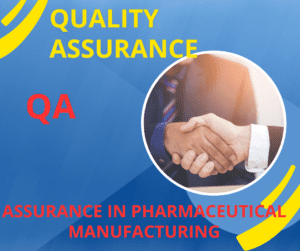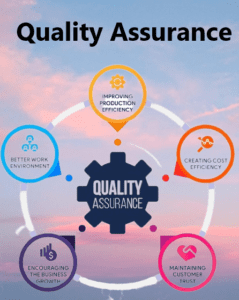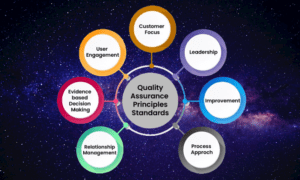Quality assurance is a crucial aspect of pharmaceutical manufacturing to ensure that products meet the required standards of safety, efficacy, and quality. It involves a range of activities and processes aimed at maintaining and improving product quality throughout the entire manufacturing process. Here are some key aspects of quality assurance in a pharmaceutical plant:
- Good Manufacturing Practices (GMP): GMP guidelines provide a framework for ensuring that pharmaceutical products are consistently produced and controlled according to quality standards. Adhering to GMP regulations is essential for maintaining the quality and integrity of the manufacturing process.

- Standard Operating Procedures (SOPs): SOPs are detailed, written instructions that define the steps and processes required to carry out specific tasks in a consistent and controlled manner. They cover various aspects of manufacturing, testing, and quality control procedures, ensuring that operations are performed uniformly.
- Documentation and Recordkeeping: Accurate and comprehensive documentation is critical for quality assurance. All manufacturing, testing, and quality control activities should be recorded in detail. This includes batch records, test results, equipment maintenance logs, and other relevant documentation.
- Quality Control Testing: Quality control tests are performed throughout the manufacturing process to verify that products meet predetermined specifications. These tests can include physical, chemical, and microbiological analyses to ensure the identity, purity, potency, and safety of pharmaceutical products.
- Equipment Validation and Calibration: Pharmaceutical manufacturing equipment should be validated and calibrated to ensure accurate and reliable performance. Validation confirms that equipment consistently produces the desired results, while calibration ensures that measurement instruments provide accurate readings.
- Supplier Qualification: Quality assurance extends beyond the pharmaceutical plant itself. Suppliers of raw materials, packaging materials, and other components should be qualified to ensure their products meet the required quality standards. This involves evaluating their quality systems, conducting audits, and assessing their compliance with relevant regulations.
- Change Control: Any changes in the manufacturing process, equipment, materials, or procedures should be carefully evaluated and documented through a change control system. This ensures that changes are properly reviewed, approved, and implemented while considering potential impacts on product quality.
- Training and Education: Adequate training programs should be in place to ensure that employees understand and adhere to quality assurance practices. Training should cover topics such as GMP, SOPs, quality control procedures, and safety protocols.
- Regulatory Compliance: Pharmaceutical plants must comply with regulatory requirements set by government agencies, such as the Food and Drug Administration (FDA) in the United States. Quality assurance programs should incorporate regulatory compliance to meet the necessary standards and guidelines.
- Continuous Improvement: Quality assurance is an ongoing process aimed at continuous improvement. Regular audits, inspections, and quality management reviews help identify areas for improvement and corrective actions to address deficiencies.
Quality Assurance vs. Quality Control, QA vs. QC
| Aspect | Quality Assurance (QA) | Quality Control (QC) |
|---|---|---|
| Definition | A set of proactive activities to ensure quality | A set of reactive activities to verify quality |
| Focus | Prevention of defects and process improvement | Detection and correction of defects |
| Objective | To prevent issues and ensure adherence to standards | To identify and rectify defects in the final product |
| Responsibility | Entire organization | Testing and inspection teams |
| Scope | Entire software development lifecycle | Testing and inspection of the final product |
| Activities | Process-oriented: planning, documentation, training | Product-oriented: testing, inspection, verification |
| Timing | Starts before development | Conducted during or after development |
| Approach | Proactive and preventive | Reactive and corrective |
| Outcome | Improves overall quality and customer satisfaction | Ensures product meets defined quality standards |
| Long-term implications | Conducted during or after the development | Focuses on detecting and resolving immediate issues |
Main Functions of the Quality Assurance QA
The functions of QA encompass a broad spectrum of responsibilities, each contributing to the overall goal of excellence in pharmaceutical manufacturing. Let us delve into a few key functions that drive this pursuit:
- Quality Management Systems (QMS): QA plays a pivotal role in developing, implementing, and maintaining robust QMS frameworks. This entails establishing comprehensive procedures, policies, and processes that govern quality-related activities across the manufacturing lifecycle. QA professionals ensure that QMS aligns with regulatory requirements and industry best practices, facilitating seamless compliance and fostering a culture of continuous improvement.
- Document Control: QA takes charge of maintaining meticulous document control systems. This includes establishing protocols for document creation, revision, and archival. By ensuring proper documentation, QA guarantees traceability, promotes consistency, and facilitates effective knowledge transfer within the organization.

- Supplier Qualification and Management: QA professionals undertake the crucial task of qualifying and managing suppliers. This involves rigorous assessments of supplier capabilities, infrastructure, and adherence to quality standards. By partnering with reliable and compliant suppliers, QA enhances supply chain integrity, mitigates risks, and maintains the quality of raw materials and components.
- Validation and Qualification: QA spearheads the validation and qualification processes essential to pharmaceutical manufacturing. This includes validating manufacturing processes, analytical methods, equipment, and computer systems. Through meticulous planning, execution, and documentation, QA ensures that these critical elements consistently deliver reliable and reproducible results.
- Change Control: QA takes charge of change control management, overseeing the evaluation, implementation, and impact assessment of changes in pharmaceutical manufacturing processes. By establishing rigorous change control protocols, QA ensures that modifications are thoroughly evaluated, properly documented, and executed in a controlled manner to maintain product quality and regulatory compliance.
- Deviation and CAPA Management: QA diligently investigates deviations from established processes and product specifications. This entails identifying root causes, implementing corrective and preventive actions (CAPA), and monitoring their effectiveness. By swiftly addressing deviations, QA promotes process optimization, minimizes risks, and drives continuous improvement.
- Audits and Inspections: QA leads internal and external audits and inspections to assess compliance with regulations, standards, and internal procedures. These audits encompass the evaluation of manufacturing facilities, processes, documentation, and adherence to Good Manufacturing Practices (GMP). By conducting comprehensive audits, QA identifies areas for improvement,
History of QA Quality Assurance in Pharmaceuticals.
The history of Quality Assurance (QA) in the pharmaceutical industry can be traced back several decades. The emphasis on QA has evolved over time, reflecting advancements in scientific knowledge, regulatory requirements, and industry best practices. Here is a brief overview of the history of QA in pharmaceuticals:
Early Years:
- In the early 20th century, pharmaceutical manufacturing was not as regulated as it is today. Quality control processes were minimal, and there was limited standardization.
- The focus was primarily on the identification and purity of active pharmaceutical ingredients (APIs) and ensuring that the final product was free from visible defects.
1950s-1960s:
- In the 1950s and 1960s, concerns about drug safety and efficacy started to gain attention. Several high-profile incidents, such as the thalidomide tragedy, underscored the need for stricter regulations and quality control.
- Regulatory agencies, such as the U.S. Food and Drug Administration (FDA), began to develop guidelines and regulations for pharmaceutical manufacturing, including the implementation of Good Manufacturing Practices (GMP).
1970s-1980s:
- The 1970s and 1980s saw significant advancements in QA practices in the pharmaceutical industry. GMP guidelines were further developed and enforced.
- The emphasis shifted from merely testing the final product to implementing quality control throughout the manufacturing process, from raw material sourcing to finished product release.
- Validation of manufacturing processes, equipment, and analytical methods became important, ensuring that processes were well-defined, controlled, and reproducible.
1990s-2000s:
- The 1990s and 2000s marked a period of increasing regulatory scrutiny and international harmonization of quality standards.
- The International Conference on Harmonisation of Technical Requirements for Registration of Pharmaceuticals for Human Use (ICH) was established in 1990. ICH guidelines, such as ICH Q7 for GMP, provided global harmonization and consistency in pharmaceutical manufacturing standards.
- Quality systems, such as Quality Management Systems (QMS) based on ISO 9000, gained prominence. These systems emphasized a holistic approach to quality assurance, encompassing documentation, training, change control, and continuous improvement.
Recent Developments:
- In recent years, there has been a growing focus on risk-based approaches to quality management. The concept of Quality by Design (QbD) has gained traction, emphasizing the proactive design of quality into the product and process.
- Regulatory agencies have placed increased emphasis on data integrity, with stricter requirements for data management and documentation practices.
- The use of advanced technologies, such as automation, data analytics, and artificial intelligence, is becoming more prevalent in QA processes, enabling better monitoring, analysis, and control of manufacturing operations.
Overall, the history of QA in pharmaceuticals reflects a shift from reactive quality control to proactive quality assurance, with an increasing focus on risk management, process optimization, and adherence to international standards. The aim is to ensure the production of safe, effective, and high-quality pharmaceutical products for patients worldwide.
Quality Assurance standards
Quality assurance (QA) standards provide organizations with a systematic framework to ensure that their products, services, and processes meet or exceed predefined quality benchmarks. These standards serve as a guiding compass, helping organizations establish and maintain a culture of quality, continuous improvement, and customer satisfaction. In this article, we explore some of the most widely recognized and influential QA standards across industries.
ISO 9000 Series: The ISO 9000 series, developed by the International Organization for Standardization (ISO), is perhaps the most renowned set of QA standards worldwide. It provides a comprehensive framework for quality management systems (QMS) and encompasses several individual standards, including ISO 9001, ISO 9004, and ISO 19011. ISO 9001 focuses on the requirements for a QMS, outlining principles such as customer focus, process approach, and continual improvement. ISO 9004 offers guidance for organizations seeking sustained success through effective quality management. ISO 19011 provides guidelines for auditing management systems.
CMMI: The Capability Maturity Model Integration (CMMI) is a globally recognized standard for process improvement. Developed by the Carnegie Mellon University’s Software Engineering Institute (SEI), CMMI offers a set of best practices that organizations can adopt to enhance their development, acquisition, and service management processes. CMMI encompasses different maturity levels, from initial (Level 1) to optimizing (Level 5), enabling organizations to assess and improve their capabilities incrementally.
ITIL: The Information Technology Infrastructure Library (ITIL) is a widely adopted framework for IT service management (ITSM). Developed by the UK’s Office of Government Commerce (OGC), ITIL provides guidelines and best practices for the planning, delivery, and support of IT services. It encompasses a series of publications that cover various aspects of ITSM, including service strategy, design, transition, operation, and continual service improvement. ITIL helps organizations align their IT services with business objectives and deliver value to customers.

GMP: Good Manufacturing Practice (GMP) is a set of regulations and guidelines that ensure the quality, safety, and consistency of pharmaceutical, medical device, and food industries. GMP guidelines, established by regulatory authorities such as the U.S. Food and Drug Administration (FDA) and the European Medicines Agency (EMA), cover areas such as facility design, process validation, equipment maintenance, documentation control, and product testing. Adherence to GMP standards is essential to guarantee the integrity and reliability of products within these industries.
TL 9000: TL 9000 is a quality management system specifically designed for the telecommunications industry. Developed by the Quality Excellence for Suppliers of Telecommunications (QuEST) Forum, TL 9000 encompasses quality requirements and metrics tailored to the unique challenges and needs of the telecommunications sector. It provides a comprehensive set of guidelines for product development, manufacturing, and service delivery, enabling organizations to enhance customer satisfaction, reduce variability, and drive continual improvement.
Quality Assurance Software
Quality assurance software plays a vital role in streamlining and enhancing quality assurance processes in the pharmaceutical industry. These software solutions help manage and automate various quality-related activities, ensuring compliance with regulatory requirements and facilitating efficient quality control. Here are some common quality assurance software used in pharmaceuticals:
- Electronic Document Management Systems (EDMS): EDMS software is used to create, manage, and control electronic documents and records. It allows for version control, document tracking, and secure storage, ensuring that documentation and standard operating procedures (SOPs) are easily accessible and up to date.
- Electronic Quality Management Systems (EQMS): EQMS software provides a centralized platform to manage quality-related processes, including document control, change control, deviation management, corrective and preventive actions (CAPA), audits, and training. It helps streamline workflows, facilitates collaboration, and ensures adherence to quality standards.
- Laboratory Information Management Systems (LIMS): LIMS software is specifically designed for managing laboratory operations, including sample tracking, testing workflows, data management, and instrument integration. It ensures efficient management of laboratory processes and helps maintain data integrity and traceability.
- Statistical Process Control (SPC) Software: SPC software allows for real-time monitoring and analysis of manufacturing processes. It helps identify process variations, trends, and potential issues, enabling proactive quality control and process improvement. SPC software can also generate statistical reports and charts for process performance evaluation.
- Complaint Handling and Adverse Event Reporting Systems: These software solutions help manage customer complaints, adverse event reporting, and product recalls. They provide a structured process for capturing, investigating, and resolving complaints, ensuring timely and appropriate actions are taken to address quality issues.
- Supplier Management Systems: Supplier management software assists in evaluating and managing suppliers based on predefined criteria, such as quality, compliance, and delivery performance. It helps track supplier qualifications, certifications, audits, and corrective actions, ensuring that only approved and reliable suppliers are used.
- Risk Management Tools: Risk management software enables systematic identification, assessment, and mitigation of risks associated with products, processes, and quality systems. It helps prioritize risks, implement preventive measures, and track risk mitigation activities.
- Validation and Calibration Management Systems: These software solutions assist in managing equipment validation and calibration activities. They schedule and track validation and calibration tasks, maintain records, and generate reports to ensure that equipment is maintained in a validated and calibrated state.
- Data Integrity and Audit Trail Systems: Data integrity software helps ensure the integrity, security, and traceability of data generated during the manufacturing and quality control processes. It includes features like audit trails, electronic signatures, access controls, and data backup and recovery capabilities.
- Training Management Systems: Training management software helps manage and track employee training programs and competency assessments. It ensures that employees receive appropriate training, certifications, and refresher courses, promoting compliance and adherence to quality standards.
These software solutions can be customized and integrated to meet the specific needs of pharmaceutical manufacturers, helping them streamline quality assurance processes, improve efficiency, and maintain regulatory compliance throughout the product lifecycle.
Frequently Asked Questions
What is the role of Quality Assurance (QA) in a pharmaceutical plant?
Answer: QA ensures that all processes, products, and systems meet established quality standards and regulatory requirements in the pharmaceutical plant.
What are some key responsibilities of the Quality Assurance department in a pharmaceutical plant?
Answer: Key responsibilities include developing and implementing quality systems, conducting internal audits, managing deviations and investigations, ensuring compliance with regulations, and overseeing document control and training programs.
How does QA ensure compliance with Good Manufacturing Practices (GMP) in a pharmaceutical plant?
Answer: Quality Assurance QA implements and maintains GMP procedures, conducts regular audits and inspections, monitors process controls, and ensures adherence to quality standards throughout the plant.
What is the purpose of validation in pharmaceutical manufacturing, and how does QA contribute to this process?
Answer: Validation ensures that processes, equipment, and systems consistently produce quality products. QA plays a crucial role in defining validation protocols, conducting validation studies, and reviewing and approving validation documentation.
How does QA handle deviations and non-conformities in a pharmaceutical plant?
Answer: Quality Assurance QA investigates deviations, identifies root causes, and implements corrective and preventive actions (CAPA) to prevent recurrence. They also ensure proper documentation and communication of deviations throughout the organization.
What is the role of QA in change control management in a pharmaceutical plant?
Answer: Quality Assurance QA reviews and approves change requests, assesses the impact of proposed changes, ensures appropriate documentation and communication of changes, and verifies the effectiveness of implemented changes.
How does QA ensure the quality of raw materials and components used in pharmaceutical production?
Answer: Quality Assurance QA establishes rigorous supplier qualification processes, conducts audits of suppliers, verifies the quality and authenticity of raw materials, and ensures compliance with specifications and standards.
What measures does QA take to prevent cross-contamination and ensure product integrity in a pharmaceutical plant?
Answer: Quality Assurance QA implements robust cleaning validation programs, establishes segregation protocols, conducts risk assessments, and ensures proper labeling and handling of materials to prevent cross-contamination.
How does QA monitor and control the quality of finished pharmaceutical products?
Answer: Quality Assurance QA performs batch release activities, conducts quality inspections and tests, reviews batch records, verifies compliance with specifications, and ensures proper documentation of product quality.
What role does QA play in conducting internal and external audits in a pharmaceutical plant?
Answer: QA plans and executes internal audits to assess compliance with quality systems, procedures, and regulations. They also facilitate external audits by regulatory authorities or customers and address any findings or observations.
How does QA ensure the effectiveness of the training programs in a pharmaceutical plant?
Answer: Quality Assurance QA identifies training needs, develops training plans and materials, conducts training sessions, evaluates training effectiveness, and maintains training records to ensure employees are competent and knowledgeable.
How does QA contribute to the continuous improvement of quality systems and processes in a pharmaceutical plant?
Answer: Quality Assurance QA initiates and supports quality improvement projects, analyzes quality data and metrics, implements statistical process control (SPC) techniques, and identifies opportunities for process optimization and enhancement.
What is the role of QA in managing product recalls or quality-related complaints in the pharmaceutical industry?
Answer: Quality Assurance QA coordinates and leads investigations into product complaints and recalls, implements corrective actions, communicates with regulatory authorities, and ensures timely resolution and prevention of similar issues in the future.
How does QA ensure the proper documentation and record-keeping in a pharmaceutical plant?
Answer: Quality Assurance QA establishes document control systems, reviews and approves documents, maintains document repositories, and ensures compliance with regulatory requirements

9 thoughts on “Quality Assurance in Pharma Plant 2023”